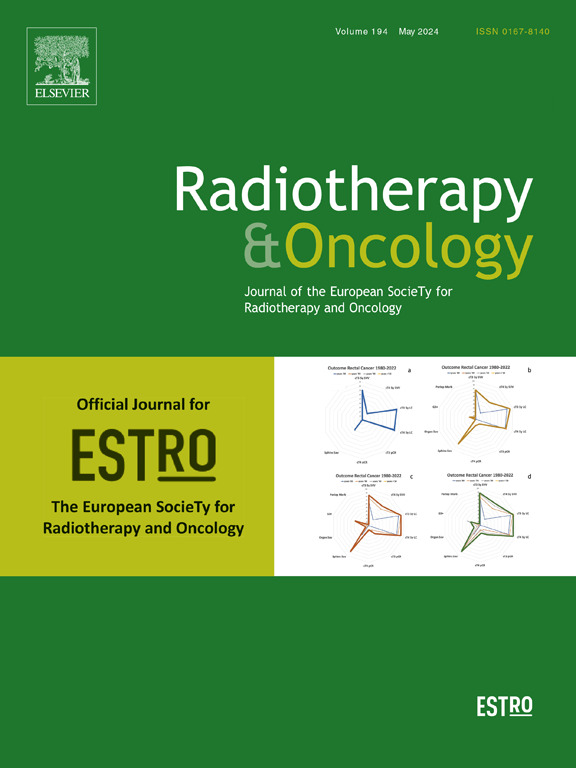Patterns of loco-regional progression and patient outcomes after definitive-dose radiation therapy for anaplastic thyroid cancer
IF 4.9
1区 医学
Q1 ONCOLOGY
引用次数: 0
Abstract
Background
The aim of this study is to characterize the patterns of loco-regional progression (LRP) and outcomes after definitive-dose intensity modulated radiation therapy (IMRT) for anaplastic thyroid cancer (ATC) with macroscopic neck disease at the time of IMRT.
Methods
Disease/treatment characteristics and outcomes for patients with unresected or incompletely resected ATC who received IMRT (≥45 Gy) were retrospectively reviewed. For those with LRP after IMRT, progressive/recurrent gross tumor volumes (rGTV) were contoured on diagnostic CTs and co-registered with initial planning CTs using deformable image registration. rGTVs were classified based on established spatial/dosimetric criteria.
Results
Forty patients treated between 2010–2020 formed the cohort. Median IMRT dose was 66 Gy (45–70 Gy); altered fractionation (AF) was used in 24 (60 %). All received concurrent chemotherapy. In addition to areas of gross disease, target volumes (TVs) commonly included: central compartment/upper mediastinum (levels VI/VII), neck levels II-V in an involved, and levels III-IV in an uninvolved lateral neck. Median overall survival was 7.1 m. Median progression free survival was 7.4 m for patients with locoregional disease and 1.8 m for patients with distant metastasis at the time of IMRT. Twenty-one patients (53 %) developed LRP at median of 10.9 m; freedom from LRP at 3 m and 12 m was 71 % (95 %CI 58–87 %) and 47 % (95 %CI 32–68 %). Forty-one individual rGTVs were identified and most occurred within the high dose (HD) TVs: Type A/central HD (n = 29, 71 %) and B/peripheral HD (n = 3, 7 %).
Conclusions
Despite an intensive treatment schedule, including AF and concurrent chemotherapy, classic radio-resistant and rapid Type A failures predominated; isolated extraneous dose failures were rare. While these findings support the IMRT and TV delineation strategies described herein, they highlight the importance of identifying novel strategies to further improve LRC for patients with unresectable disease without targetable mutations for contemporary neo-adjuvant strategies.
甲状腺无节细胞癌确定剂量放射治疗后的局部区域进展模式和患者预后。
研究背景本研究的目的是描述接受确定剂量调强放射治疗(IMRT)时存在颈部大面积病变的无性甲状腺癌(ATC)的局部区域进展(LRP)模式和治疗后的预后:回顾性研究了接受IMRT(≥45 Gy)治疗的未切除或未完全切除ATC患者的疾病/治疗特征和结果。对于接受 IMRT 后出现 LRP 的患者,在诊断 CT 上绘制了进展/复发肿瘤总体积(rGTV)轮廓,并使用可变形图像配准技术与初始规划 CT 共同配准:2010-2020年间接受治疗的40名患者组成了队列。中位IMRT剂量为66 Gy(45-70 Gy);24例(60%)使用了改变分层(AF)。所有患者均同时接受了化疗。除了大体病变区域外,靶体积(TV)通常包括:中央区/上纵隔(VI/VII层)、受累颈部II-V层和未受累侧颈部III-IV层。总生存期中位数为 7.1 米。接受 IMRT 时,局部疾病患者的中位无进展生存期为 7.4 个月,远处转移患者的中位无进展生存期为 1.8 个月。21 名患者(53%)在中位 10.9 米处出现 LRP;在 3 米和 12 米处无 LRP 的比例分别为 71% (95 %CI 58-87 %) 和 47% (95 %CI 32-68%)。共确定了 41 个 rGTV,其中大部分发生在高剂量(HD)电视中:结论:尽管采用了强化治疗计划,包括房颤和同期化疗,但典型的放射耐药和快速A型失败仍占主导地位;孤立的额外剂量失败很少见。虽然这些发现支持本文所述的 IMRT 和 TV 划分策略,但它们也强调了确定新策略的重要性,以进一步改善患有不可切除疾病且无靶向突变的患者的 LRC,从而采用现代新辅助策略。
本文章由计算机程序翻译,如有差异,请以英文原文为准。
求助全文
约1分钟内获得全文
求助全文
来源期刊

Radiotherapy and Oncology
医学-核医学
CiteScore
10.30
自引率
10.50%
发文量
2445
审稿时长
45 days
期刊介绍:
Radiotherapy and Oncology publishes papers describing original research as well as review articles. It covers areas of interest relating to radiation oncology. This includes: clinical radiotherapy, combined modality treatment, translational studies, epidemiological outcomes, imaging, dosimetry, and radiation therapy planning, experimental work in radiobiology, chemobiology, hyperthermia and tumour biology, as well as data science in radiation oncology and physics aspects relevant to oncology.Papers on more general aspects of interest to the radiation oncologist including chemotherapy, surgery and immunology are also published.
 求助内容:
求助内容: 应助结果提醒方式:
应助结果提醒方式:


